Single-cell and spatial transcriptome analyses reveal tumor heterogeneity and immune remodeling involved in pituitary neuroendocrine tumor progression
- PMID: 40442104
- PMCID: PMC12122724
- DOI: 10.1038/s41467-025-60028-5
Single-cell and spatial transcriptome analyses reveal tumor heterogeneity and immune remodeling involved in pituitary neuroendocrine tumor progression
Abstract
Pituitary neuroendocrine tumors (PitNETs) can be invasive or aggressive, yet the mechanisms behind these behaviors remain poorly understood, impeding treatment advancements. Here, we integrat single-cell RNA sequencing and spatial transcriptomics, analyzing over 177,000 cells and 35,000 spots across 57 tissue samples. This comprehensive approach facilitates the identification of PitNETs tumor populations and characterizes the reconfiguration of the tumor microenvironment (TME) as PitNETs progress and invade. We trace the trajectory of TPIT-lineage PitNETs and identify an aggressive tumor cluster marked by elevated p53-mediated proliferation and a higher Trouillas classification, both associated with tumor progression. Additionally, we document the heterogeneity of immune stromal cells within PitNETs, particularly noting the enrichment of SPP1+ tumor associated macrophages (TAMs) in invasive tumors. These TAMs facilitate tumor invasion through the SPP1-ITGAV/ITGB1 signaling pathway. Our in-depth single-cell and spatial analysis of PitNETs uncovers the molecular dynamics within the TME, suggesting potential targets for therapeutic intervention.
© 2025. The Author(s).
Conflict of interest statement
Competing interests: The authors declare no competing interests.
Figures
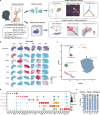

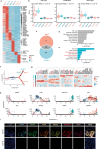
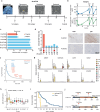
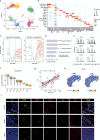
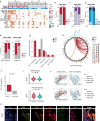
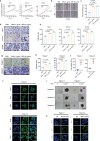

Similar articles
-
Single-cell transcriptomics reveal distinct immune-infiltrating phenotypes and macrophage-tumor interaction axes among different lineages of pituitary neuroendocrine tumors.Genome Med. 2024 Apr 24;16(1):60. doi: 10.1186/s13073-024-01325-4. Genome Med. 2024. PMID: 38658971 Free PMC article.
-
Single-cell transcriptomics identify a novel macrophage population associated with bone invasion in pituitary neuroendocrine tumors.J Exp Clin Cancer Res. 2025 Jan 27;44(1):27. doi: 10.1186/s13046-025-03296-9. J Exp Clin Cancer Res. 2025. PMID: 39865310 Free PMC article.
-
Comprehensive mapping of somatotroph pituitary neuroendocrine tumour heterogeneity using spatial and single-cell transcriptomics.Clin Transl Med. 2024 Nov;14(11):e70090. doi: 10.1002/ctm2.70090. Clin Transl Med. 2024. PMID: 39548559 Free PMC article.
-
Immune landscape and progress in immunotherapy for pituitary neuroendocrine tumors.Cancer Lett. 2024 Jun 28;592:216908. doi: 10.1016/j.canlet.2024.216908. Epub 2024 Apr 25. Cancer Lett. 2024. PMID: 38677640 Review.
-
scRNA sequencing technology for PitNET studies.Front Endocrinol (Lausanne). 2024 Jul 24;15:1414223. doi: 10.3389/fendo.2024.1414223. eCollection 2024. Front Endocrinol (Lausanne). 2024. PMID: 39114291 Free PMC article. Review.
Cited by
-
Collagen in pituitary adenomas: A comprehensive review of biological roles and clinical implications.J Clin Transl Endocrinol. 2025 Jul 10;41:100408. doi: 10.1016/j.jcte.2025.100408. eCollection 2025 Sep. J Clin Transl Endocrinol. 2025. PMID: 40697902 Free PMC article. Review.
References
-
- Melmed, S. Pituitary-tumor endocrinopathies. N. Engl. J. Med.382, 937–950 (2020). - PubMed
-
- Mete, O. & Lopes, M. B. Overview of the 2017 WHO classification of pituitary tumors. Endocr. Pathol.28, 228–243 (2017). - PubMed
-
- Tritos, N. A. & Miller, K. K. Diagnosis and management of pituitary adenomas: a review. JAMA329, 1386–1398 (2023). - PubMed
-
- Molitch, M. E. Diagnosis and treatment of pituitary adenomas: a review. JAMA317, 516–524 (2017). - PubMed
-
- Petersenn, S. et al. Diagnosis and management of prolactin-secreting pituitary adenomas: a pituitary society international consensus statement. Nature reviews. Endocrinology19, 722–740 (2023). - PubMed
MeSH terms
LinkOut - more resources
Full Text Sources
Medical
Research Materials
Miscellaneous

